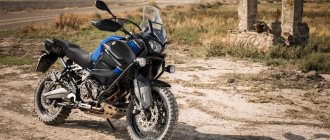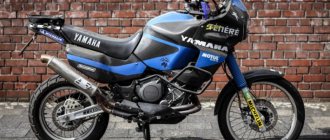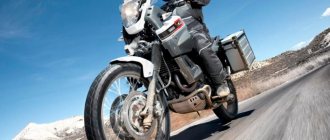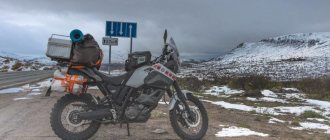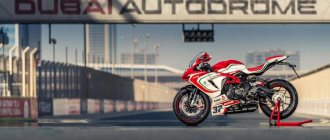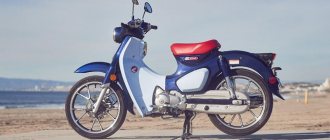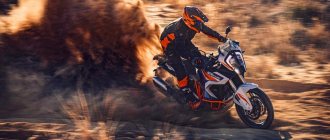There were times when I was quite happy with a simple push-button telephone that was used solely for conversations. Now I have a top-end smartphone with a 5-inch screen, and I often find myself wasting time foolishly scrolling through work screens, admiring icons and widgets. Why this lyrical digression in a text about a motorcycle? Moreover, electronics and high technologies are increasingly being introduced into the body of two-wheeled vehicles. In past years I have ridden more than thirty thousand kilometers on Super Tenere. I won’t lie, I liked this big and comfortable touring-enduro. I liked it primarily because it was simple, like a cast iron iron. Because simple means reliable, it won’t let you down in difficult times. But Yamaha decided to keep up with its competitors. The Japanese upgraded the Super Tenere - they slightly modified the finish and... stuffed it with electronics. First of all, the suspension, introducing electronic control of its elements.
On the old Tenere they had mechanical adjustments, and over the years I have turned the corresponding knobs at most three times. Considering this fact, the new “trick” of Yamaha designers seemed frankly far-fetched to me. Is it worth changing the motorcycle for these innovations?
Super Tenere has rally motorcycles in its ancestors, which brought the company victories in Dakar
However, the matter was not limited to just one pendant. Yes, the new Super Tenere with the E index in the name is no different from the old one from a distance. But upon closer inspection, the “Electronic” reveals itself with wires extending from above into the front fork stays, an abundance of some blocks in the area of the rear shock absorber, and a new large instrument panel. Plastic inserts appeared in the space under the headlights and under the passenger seat, and the shape of the windshield, rear fender and exhaust pipe casing changed. The side stand is now made of hardened aluminum. From the press release I also learned that the engine received new camshafts, larger valves, new piston rings and exhaust. As a result, power increased to 112 hp and torque increased to 117 Nm. Already at the first pull, I noticed more “meat” at medium speeds. Well, when starting in the first two gears, the motorcycle generally shoots forward like a bullet. The power map offers a choice of two modes - S and T (sport and touring), a braking system with ABS, traction, heated grips... It seems that now everything is grown-up, like the top competitors. But, I admit, during the whole day of the test, while I was wandering around country roads, I did not notice a strong difference compared to the previous Tenere. I just realized once again that electronics are good, but it’s not bad without it!
Glass
Its mechanical adjustment in practice is not entirely convenient.
Here the “smartphone effect” is manifested in all its glory. Suspension units now have expanded functionality, which means you start tinkering with it all the time. It's fun at first, but eventually you realize you're distracted from driving. I sat down the passenger, clicked the buttons on the second helmet on the instrument panel, drove along the highway, released the suspension, and tightened it in the city. Everything works smoothly, but the settings interfaces are not the simplest. Using two rocker buttons, you need to find a specific mode on the LCD panel, then click on the required number of adjustment positions and wait until they “take effect”. Moreover, the preload in all possible combinations is set only statically, and applying the selected position takes about a minute. It’s like on a smartphone: go ahead, I’ll catch up with you as soon as I upload the photo, 3G works well in this place!
Trunk
Excellent and powerful already in stock.
There is complete order here , but the hydraulic settings change right on the go. There are three modes to choose from: Standard, Soft and Hard, divided into seven levels each. Total - twenty-one hydraulic stiffness positions and four preload positions. Together 84 options! On the first day, I simply exhausted myself with searching for optimal values. I stopped for this probably fifty times. Still, a large selection is good, but a small selection is even better! And if in a smart phone it is possible to reset to factory settings, that is, return to the state “from the assembly line,” then this will not work with a motorcycle. In general, on the second day I remembered with sadness and longing the good old “mechanical” Super Tenere, on which I got a thrill from driving, and did not torment my brain with settings options.
TEXT: LIU WASEDA
TEST DRIVE: Yamaha Tenere XT1200Z (2010) – Pros and cons
Although the motorcycle was taken for a long test, let's say, for a season, in just three weeks the most complete, multi-faceted test of 9000 km was completed, during which I tried to understand whether Yamaha had succeeded in its idea of creating a universal tour enduro - a competitor to the BMW R1200GS.
MOTOGONKI.RU, November 18, 2010 — TEST BEGINS: YAMAHA TENERE XT1200Z — THE DUTCH
Engine
Yamaha's requirement for fuel quality is one of the mysteries of this motorcycle: “Pour no less than 95 Super!” - warns the sticker on the gas tank. Theoretically, it is designed to conquer the toughest off-road terrain: Africa, South America and other endlessly unorganized lands. Where does “Super” come from in the outskirts of Zimbabwe?! In fact, the engine “ate” even the dubious quality “92” without any problems. The ignition is provided by two spark plugs in each cylinder plus the so-called “anti-knock” system. The real difference is only in consumption: the lower the octane number, the higher it is. So in this regard, Yamaha has performed a small technological miracle.
The Super Tenere engine is compact and very playful in the middle of the range, but at the bottom and at the top...
At the same time, for the first time in a long practice, I “dried out” between two refills. Calculating consumption using Super Tenere devices is not easy, I already wrote about this in the last issue. In theory, the XT1200Z consumes 9L/100km at 150km/h on the highway (compared to the R1200GS' 6.7L at the same pace). On the ground and when driving on roads of questionable quality, mileage increases significantly. One way or another, the price of the first division of the level indicator is 105-125 km, the second - about 75, the third - less than 50. It was possible to drive 210-250 km to the reserve volume. Finally, with the remaining 4 liters I managed to go 61 km before the engine died down. Then I saw the number “287” on the odometer, and I was only 5 km short of refueling (the companions on the BMW didn’t even have the “reserve” on at that time). But this is not the limit of the capabilities of the 2-cylinder 1199 cc “in-line” engine. Of course, it is designed for another application - climbing gravel roads at speeds of up to 90 km/h, climbing hard-to-reach mountain paths, overcoming fords and other off-roads. At the same time, you can travel 350 km on one gas station. But to get to the mountains, for example, from Moscow you need to cover almost 1,500 km and you will have to pay exorbitant prices for it! In any case, it is recommended to take an emergency supply of fuel with you.
The dashboard is very very spartan, however, this is 2010! But we already have Multistrada...
The first impressions of the engine were very vague: the first and second gears are “indistinct” and short, useless on the road, and it’s easy to block the engine with sloppy clutch operation. But when driving at low speeds, it's important to maintain balance, and the Super Tenere has a couple of tricks for this: the cylinder block is tilted forward with two overhead camshafts and two balancer shafts, and the engine itself sits as low as possible in the frame. The all-terrain vehicle steers perfectly, even too easily, despite almost 300 kg when fully loaded...
Vibrations are something that cannot be avoided, even if armed with balancers. The creepiest and most disturbing ones begin at 4000 rpm. and decrease by about 5000 rpm. At this moment, a second wind seems to open in the engine and a significant pickup is felt. Yamaha cruising speed is 120-130 km/h. This way you can avoid overspending. At the same time, the fifth and sixth gears are truly “rubbery”. So, reluctantly, but without hesitation, the XT1200Z starts from second, and as soon as the needle crosses the 80 km/h mark, switch to sixth and - forward, to the maximum (according to GPS) 195 km/h!
Chassis
Driving a loaded SUV on the highway at such speed is not easy. It's all due to the cleverly balanced chassis. In the first half of the journey, I constantly encountered the same problem that Valentino Rossi faced during the development of his Ducati Desmosedici: he could not fully load the front wheel so that it began to “work” in corners and on straights. The motorcycle accelerated to 160 km/h, the wheel began to “walk”, which several times led to wobbling on longitudinal irregularities. I solved the problem after numerous experiments with clamping the rear shock absorber: I managed to minimize the potentially dangerous effect. At the same time, Super Tenere did not care about the quality of coverage and other irritants.
Yamaha Super Tenere XT1200Z Frame
The long-awaited test was an exit onto the D1 highway, leading from east to west of the Czech Republic. 276 km of concrete road, built back in 1971. For any motorcyclist, driving along the D1, especially the first 100 km from Brno, is torture, especially in the right lane. The concrete blocks are not poured with perfect accuracy and are slightly inclined relative to each other, which creates a unique “comb” effect when driving, especially at speeds above 120 km/h. A month earlier, I drove this route twice on a “clean” Suzuki Burgman 650 road bike. I repeat, torture. With the Super Tenere chassis - complete indifference to the presence of joints and differences in slab heights! Q.E.D.
The ground clearance of more than 200 mm is enough to jump onto the curb at the right moment and sit in a place inaccessible to cars. In Warsaw I was caught in an incredible storm. Half of the city was submerged under water, flooding was observed everywhere, which led to many kilometers of traffic jams. Not for me! Three times I “waded” newly formed lakes in the middle of city highways, the water reached the gear shift foot. If it weren’t for the soaking wet touring motorcycle boots, I wouldn’t have paid any attention to the “puddles.” But the motorists... they had a hard time!
Wheels
Knowing that 90% of the journey would be on the highway, before the trip I installed the new Continental ContiTrailAttack, specially created for such motorcycles: mostly asphalt, with the ability to go off-road. Over the entire 9,000 km, there was not a single instance of stalling, despite the narrow “off-road” front and significantly overloaded rear. All thanks to the uniform distribution of the compound over the entire surface of the frame and a successful pattern: even in the most terrible bad weather, the entire tread area was used. After redistributing the load on the chassis, it was possible to better load the front-end, and finally, some wear appeared on the front tire... at about 6000 km!
Basic tires lasted only 5000 km. Therefore, before the test, brand new ContiTrailAttack was installed on the motorcycle - this is what we need!!!
The new “conti” are durable and grippy, they suited me perfectly. But if you know for sure that at least a third of the route lies off the asphalt, install ContiEscape “with checkers”. In truth, installing tires only “with the ability” to leave the road deprives Tenere of many of the purely off-road options built into it by its designers. I had to switch to the “TCS2” (Off-road) mode so that when driving onto mature grass and dirt, my rear wouldn’t go wild. Torque was electronically limited, traction was equalized by the YCC-T system. Otherwise, I would have ended up on my side.
High seat
Both good and bad. Of course, 870 mm in the base is convenient for off-road driving when you have to stand up on the pegs. On the highway, you want to sit as low as possible in order to hide behind the windshield that can barely cope with its duties. Luckily, the under-seat spacer can be removed or put back in place in a matter of seconds. You can take it with you and use it for its intended purpose. I would have done so, but I left it in the garage, which caused me to suffer in the mountains and on long hauls. With a low seating position (845 mm), the legs are in a significantly bent state, and the knee joints begin to ache after an hour and a half to two hours of riding. If I sat a little higher, the comfortable travel time would increase.
Baggage
The proprietary system of aluminum panniers left ambivalent impressions. They themselves are reliable - this is a plus. But I was disappointed with the interior design. The top 30-liter box fits one helmet and nothing else. What if something softer? Yes, you can “archive” your sleeping bag and “foam” with your knee, and again understand that this place has been exhausted. Active use of the container is limited by Yamaha's requirements for maximum loading, because the case itself weighs 5 kg, and you can't take it with you to your hotel room. The side cases are asymmetrical: the right one – 32 liters, the left one – 29: 3 liters of useful capacity are lost due to the proximity to the massive exhaust, and besides, it also gets hot.
About 50 kg of cargo constantly traveled with me. But the panniers themselves - they are supposed to hang on a motorcycle: they are heavy!
The useful total volume of the system in my case was only 60 liters out of a possible 90, so I had to load a 76-liter saddlebag. None of the side cases could fit a photo backpack: the set of equipment had to be divided into separate, small cases, and as a result, a lot of space was lost. The same backpack fit perfectly into the seat space of most of the tested maxi-scooters, as well as the panniers of BMW touring cars. All three Yamaha panniers are completely sealed - rain is not a problem.
Service on the go
XT1200Z displacement engine with 110 hp. at 7250 rpm, it would seem that it should give something more at low and medium speeds. But the maximum torque of 114 Nm occurs only at 6000 rpm.
The R1200GS has similar power, the “boxer” reaches its peak at the same speed, but its torque is “juicier” - 120 Nm. Yamaha engineers relied on the machine to be “twisted” in order for it to dig and grip. When you try to drive in a “comfortable” speed zone on asphalt, you involuntarily work the throttle and accelerate. I'm not sure if this applies to all XT1200Zs, but the test subject suffered from oil gorging. During the trip I changed all 3.5 liters - by topping up. I associate this with long hauls in modes from 5000 to 6000 rpm. You should factor in your travel expenses and take a couple of liters of Yamalube with you (it’s not easy to find branded oil in Europe, and even more so in the Russian outback). No other expenses were required to maintain the motorcycle during the entire run.
Yamaha Super Tenere (2010) in red and blue
But they might appear! First of all, due to the not very convenient position of the “parking” selector in the ignition switch. It's easy to miss the steering wheel lock and ignore the side lights in bright sunlight. Once, I was almost left without power - in just 4 hours of parking the battery was completely dead. Fortunately, through the efforts of three mechanics of the British racing team, they managed to start the Super Tenere from a “push start” - they simply pushed me away. Charging the gel battery to 70% took about an hour and a half, for which we used a “smart” device: “You need to keep your eyes open with this battery: you shouldn’t charge it head-on - you’ll lose up to 25% of the power,” noted the owner of a motorcycle service center.
...just don't forget to change the road Battle Wing to the trailing Trail
Total
Is it worth overpaying 206 thousand for the BMW R1200GS in the basic configuration, 240 thousand for the Adventure, or taking the Super Tenere? It's unlikely that I would buy a Yamaha for everyday use. That's not what he's for. And for tourism? Just not for trips to Europe! Rather, in the opposite direction - to the outback of Russia, for a trip to Ukraine, the Far East. I wouldn’t mind having the motorcycle travel part of the way in the back of a support vehicle.
This is the difference: in the deeper and more comfortable BMW saddle, such thoughts did not even occur to me! And the cost per kilometer for the GS is significantly lower than 4 rubles, all other things being equal. But if there are no tasks to overcome 1500 km per day, and you are ready to slowly and economically travel 600-700 km per day, the XT1200Z is your choice.
START OF TEST: YAMAHA TENERE XT1200Z – THE DUTCH
Yamaha Tenere XT1200Z (2010): 1199 cm3, 110 hp. s., curb weight - 261 kg.
Total mileage during testing: 9000 km Gasoline costs (790 l): about 1050 euros Other costs: 3.5 liters Yamalube p/s - 52 euros. Net cost of 1 km run: 0.12 euros
The motorcycle was provided by www.yamaha-motor.ru First published in MOTOREVYU magazine 9/2010 and 10/2010 Photo by the author and Yuri Banchukov.
